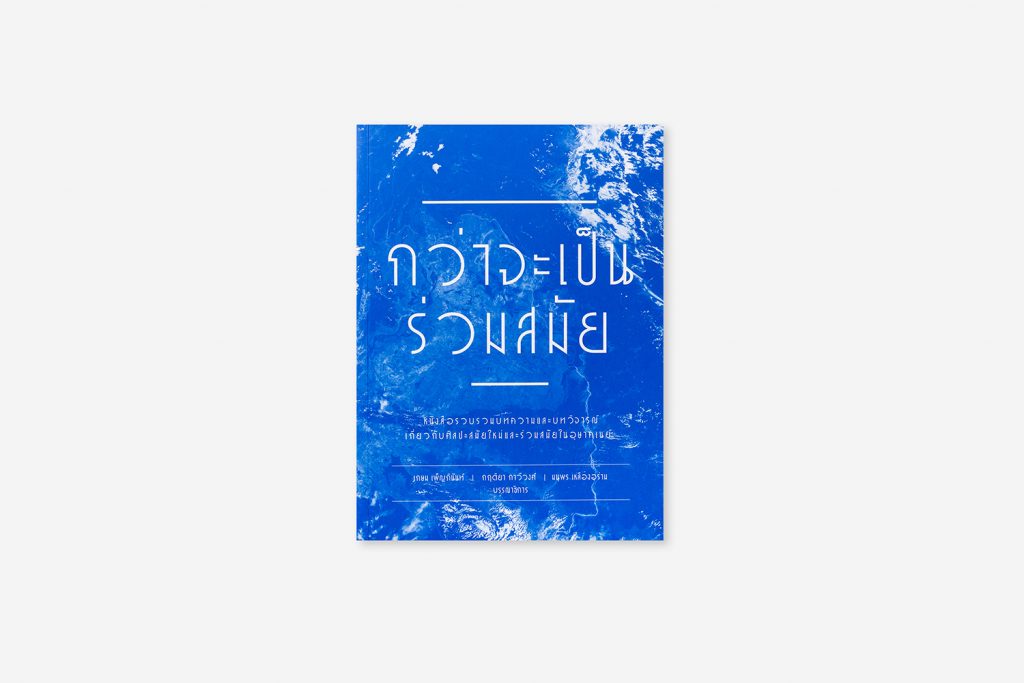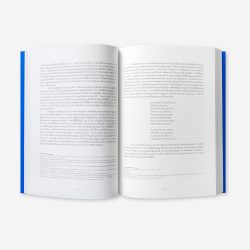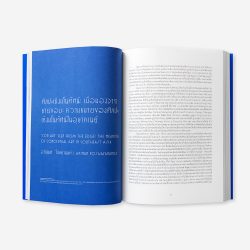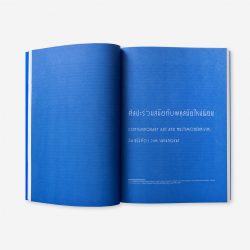A COLLECTION OF ESSAYS THAT ALLOWS FOR US READERS TO UNDERSTAND THE CONNECTIONS BETWEEN THE REGION’S ART HISTORY AND THE GENERAL HISTORY OF THE ART WORLD.

Edited by Kasem Phenpinant, Gridthiya Gaweewong and Manuporn Luengaram
Office of Contemporary Art & Culture, Ministry of Culture
Paperback, 340 pages, 17×23.5 cm
ISBN 978-6-16543-402-7
TEXT: WICHIT HORYINGSAWAD
PHOTO: KETSIREE WONGWAN
(Scroll down for English)
ประวัติศาสตร์ของสำนึกร่วมของความเป็นอุษาคเนย์ หรือเอเชียตะวันออกเฉียงใต้ แท้จริงแล้วอาจเพิ่งเริ่มมาไม่นานนี้เอง เพราะหากย้อนกลับไปในสมัยสงครามโลกครั้งที่สอง ฝ่ายสัมพันธมิตรเข้ามาตั้งศูนย์บัญชาการรบเพื่อทำสงครามกับญี่ปุ่น โดยใช้ชื่อเรียกศูนย์ในภูมิภาคว่า South-East Asia Command (SEAC) ดังนั้นการมองประเทศแถบนี้เป็นลักษณะภูมิภาคของชาติตะวันตกจึงเริ่มต้นจากตรงนี้ ก่อนที่จะก่อตัวชัดเจนเป็นเรื่องเป็นราวในทศวรรษ 1950 ด้วยการสนับสนุนโดยพี่ใหญ่อย่างสหรัฐอเมริกา ภายใต้บริบทของความขัดแย้งทางอุดมการณ์ทางการเมืองในยุคสงครามเย็น และพัฒนามาเป็นประชาคมเศรษฐกิจอาเซียนอย่างที่เป็นอยู่ในปัจจุบัน
ความเหมือน/ความต่าง ความหลากหลายซับซ้อน และการมีจุดร่วมกันของศิลปะในประเทศต่างๆ หรือแม้กระทั่งสำนึกแบบชาตินิยมที่ปะทะกับพลังของโลกาภิวัฒน์ ภายใต้ร่มใหญ่ของความเป็น “อุษาคเนย์” ยังเป็นหัวข้อให้ชวนสงสัยและตั้งคำถามเสมอ ด้วยบริบททางสังคม การเมือง และวัฒนธรรมที่แตกต่างกันมาก การพยายามทำความเข้าใจเพื่อคลี่คลายความซับซ้อนที่ว่านี้ เป็นจุดเริ่มต้นที่คณะบรรณาธิการ เกษม เพ็ญภินันท์ กฤติยา กาวีวงศ์ และมนุพร เหลืองอร่าม ตัดสินใจเข้ามาคัดเลือกบทความที่น่าสนใจที่ช่วยให้เราเห็นความเชื่อมโยงกันระหว่างประวัติศาสตร์ศิลปะที่เกิดขึ้นในภูมิภาค กับประวัติศาสตร์ของโลกศิลปะในภาพรวมสำหรับหนังสือเล่มนี้

บทความที่นำมารวบรวมไว้ในเล่ม แบ่งออกเป็น 3 หัวข้อหลักใหญ่ๆ เพื่อให้เห็นภาพในประเด็นต่างๆ ที่สำคัญได้ชัดเจนขึ้น คือ ประวัติศาสตร์ศิลปะอุษาคเนย์ในมุมมองแบบภูมิภาคนิยม กระบวนการเคลื่อนไหว ศิลปะในอุษาคเนย์ และหัวข้อสุดท้ายคือ กรณีศึกษา: ประวัติศาสตร์นิทรรศการศิลปะ
แม้หนังสือเล่มนี้จะได้รับเงินทุนที่สนับสนุนการวิจัยและการตีพิมพ์จากหลายหน่วยงาน แต่เพราะปัญหาเรื่องงบประมาณ จึงทำให้เผยแพร่แจกจ่ายอยู่ในวงจำกัด อย่างไรก็ตาม หลังจากที่มีผู้ให้ความสนใจเป็นจำนวนมาก ทำให้อาจมีการพิมพ์ครั้งที่ 2 เพื่อจัดจำหน่ายและเผยแพร่ในวงกว้างขึ้น โดยจะจัดรูปเล่มใหม่ให้อ่านง่ายขึ้น และเพิ่มเติมภาพประกอบที่เกี่ยวข้อง โดยจะมีการเพิ่มบทความ Critical Reflection ที่มีต่อ Anthology เล่มนี้ที่เขียนโดย เกษม เพ็ญภินันท์ เข้าไปด้วย สำหรับผู้ที่สนใจหนังสือเล่มนี้แต่ไม่รู้ว่าจะหาอ่านได้จากที่ไหนนั้น โปรดอดใจรอกันต่อไป


The history of the collective consciousness regarding the Southeast Asian identity only began just very recently, dating back to the World War II period when the Allies set up the South-East Asia Command (SEAC) to fight Japan in the South-East Asian Theatre. The West’s perception of the area as a geographical region took place then. It later evolved with its own stories throughout the 1950s, with the United States being a powerful supporter under the conflicted political ideologies that came about during the Cold War before the region continued to develop into the ASEAN Economic Community it is today.
The similarities/differences/diversity/complexity and common traits of art or the clash between nationalist ideals and globalization of countries under the big Southeast Asian umbrella have always been issues of curiosity and questions. With such diverse social, political and cultural backgrounds, an attempt to understand such complexity is the starting point that caused the team of editors, namely, Kasem Phenpinant, Gridthiya Gaweewong and Manuporn Luengaram, to select a collection of essays for the ‘Anthology of Southeast Asian Modern and Contemporary Art’ that allows for us readers to understand the connections between the region’s art history and the general history of the art world.
The essays are divided into three main categories: the history of Southeast Asian art from the Regionalism point of view, artistic movements in Southeast Asia, and Case Studies: History of Art Exhibitions, to render clear depictions of different issues.
Although the book received funding from a number of organizations for its research and publication, the budgetary dilemma caused the distribution to be rather limited. Nevertheless, after satisfactory feedback, a second printing is planned to take place alongside wider distribution and promotion. A new layout will be designed making the text easier to read with additional illustrations added including the ‘Critical Reflection’ essay on the Anthology written by Kasem Phenpinant. For those who are interested in the book but do not know where to get it, remain patient. It won’t be long now (?) .




